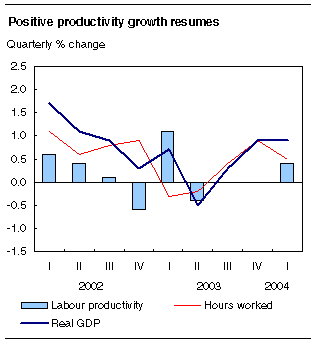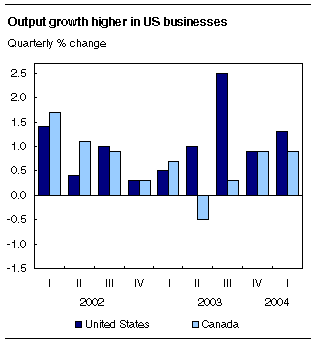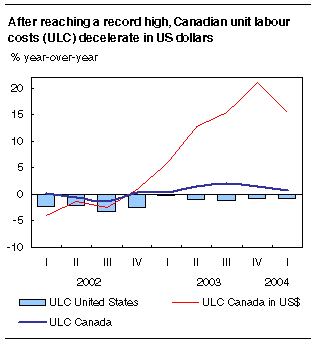
















 |
|
 |                |
Information identified as archived is provided for reference, research or recordkeeping purposes. It is not subject to the Government of Canada Web Standards and has not been altered or updated since it was archived. Please "contact us" to request a format other than those available.

|

Friday, June 11, 2004 Labour productivity, hourly compensation and unit labour costFirst quarter 2004Labour productivity in Canada's business sector rose 0.4% between January and March this year, the first quarter-to-quarter gain in a year. The increase follows a lackluster performance during much of 2003. Labour productivity fell during the second quarter last year, and was virtually flat during the third and fourth quarters. The last time productivity rose was during the first quarter of 2003 when it went up 1.1%. 
In the United States, first-quarter growth in labour productivity this year was 1.2%, three times Canada's pace. Productivity growth south of the border has outpaced the growth in Canada since the first quarter of 2003. Higher productivity, as measured by production per hour worked, occurs when GDP increases faster than hours worked. In general, productivity growth helps improve prosperity and standards of living.
During the last two quarters of 2003 in Canada, when productivity growth was flat, gains in production were matched by increases in hours worked. Between January and March this year, productivity increased in Canada largely because output growth remained the same as in the last quarter of 2003, while the growth in hours worked slowed down. US outpaces Canada for four straight quartersProductivity growth south of the border has outpaced Canada's growth for four straight quarters. Between January and March this year, real production grew more in American businesses than it did among their Canadian counterparts as it has since the second quarter of 2003. In the American business sector, production growth accelerated from 0.9% in the fourth quarter of 2003 to 1.3% in the first quarter. The first-quarter increase in American production was widespread, with advances in all major sectors (households, business, government and the non-resident sector). In the first quarter, Canadian businesses had the same rate of production growth as in the final quarter of 2003 (0.9%). A recovery in consumer spending and sustained export growth were the main contributors to the strength of Canadian production. 
Labour productivity increased faster in the United States both because businesses there increased their output more than in Canada and because there was a smaller gain in hours worked than in Canadian businesses. Canadian businesses recorded a 0.5% increase in production hours worked in the first quarter of 2004, while the increase south of the border was only 0.2%. This continues the trend of stronger growth in hours worked in Canada than in the United States. Strong Canadian dollar hurt competitive position of Canadian businessesAmerican businesses continue to have a significant advantage over Canadian businesses with respect to changes in labour costs. On an annual basis, the growth of unit labour costs in Canadian businesses has been slowing over the last three quarters, from 2.0% in the third quarter of 2003 to 0.8% in the first quarter of 2004. By comparison, American businesses have enjoyed declining unit labour costs for nine straight quarters. In the first quarter, unit labour costs in the United States decreased at an annual rate of 0.8%. When the exchange rate is taken into account, American businesses enjoy an even greater advantage in the first quarter of this year compared with a year earlier. With the value of the Canadian dollar relative to the US dollar rising 12.7% between the first quarter of 2003 and the same quarter of 2004, the gap in the growth of unit labour costs between the two countries continues to favour the United States by a considerable margin. 
Year-over-year, unit labour costs in US dollars registered a 15.4% growth in Canada in the first quarter, whereas they were down 0.8% in the United States. In the last quarter of 2003, unit labour costs in Canada (measured in US dollars) soared 21.0% on an annual basis to a record high, as the Canadian dollar rose 16.2% relative to the US dollar. Productivity gaps narrow following recent revisions in CanadaData released today incorporate revisions to Canadian gross domestic product (GDP) for 2000 to 2003. Revised American data are expected next September. Overall, the 2000 to 2003 revisions increased the growth rate of labour productivity in Canada for each of the last four years. For that period, the revisions ranged from 0.1% to 0.4%, narrowing the gap in productivity growth between Canada and the United States.
Canadian businesses outperformed their American counterparts in productivity in only one of the past four years: 2000. The difference in productivity growth for the year 2000 increased from 0.9 percentage points in Canada's favour before revision to 1.0 percentage points after revision. Since then, the gap in productivity growth varied from 1.2% to 4.4% per year in favour of the United States before revision, compared with 0.8% to 4.1% after revision. However, it is important to note that these annual productivity differences are based on preliminary data, which are subject to revision. Since 1998, these gaps have generally shrunk following revisions to the preliminary data. The revisions also resulted in a change over the medium term, as the average annual productivity growth for the period from 1996 to 2002 was revised upward from 2.3% to 2.5%. This revised rate is still slightly below the US rate of 2.9% for the same period. The revisions had virtually no effect on average annual productivity growth in Canada for the period from 1987 to 2002. The average gap in annual productivity growth in favour of the United States declined from 0.6 percentage points before revision to 0.5 percentage points after revision. Available on CANSIM: tables 383-0008 and 383-0012. Definitions, data sources and methods: survey number 5042. A more comprehensive analysis, including additional charts and tables, is now available in the Canadian Economic Accounts Quarterly Review (13-010-XIE, free). From the Our products and services page, under Browse our Internet publications, choose Free, then National accounts. The second quarter 2004 data for labour productivity, hourly compensation and unit labour cost will be released on September 13. For more information, or to enquire about the concepts, methods or data quality of this release, contact Jean-Pierre Maynard (613-951-3654; fax: 613-951-3292; maynard@statcan.gc.ca), Micro-Economic Analysis Division.
| |||||||||||||||||||||||||||||||||||||||||||||||||||||||||||||||||||||||||||||||||||||||||||||||||||||||||||||||||||||||||||||||||||||||||||||||||||||||||||||||||||||||||||||||||||||||||||||||||||||||||||||||||||||||||||||||||||||||||||||||||||||||||||||||||||||||||||||||||||||||||||||||||||||||||||||||||||||||||||||||||||||||||||||||||||||||||||||||||||||||||||||||||||||||||||||||||||||||
|
|
|